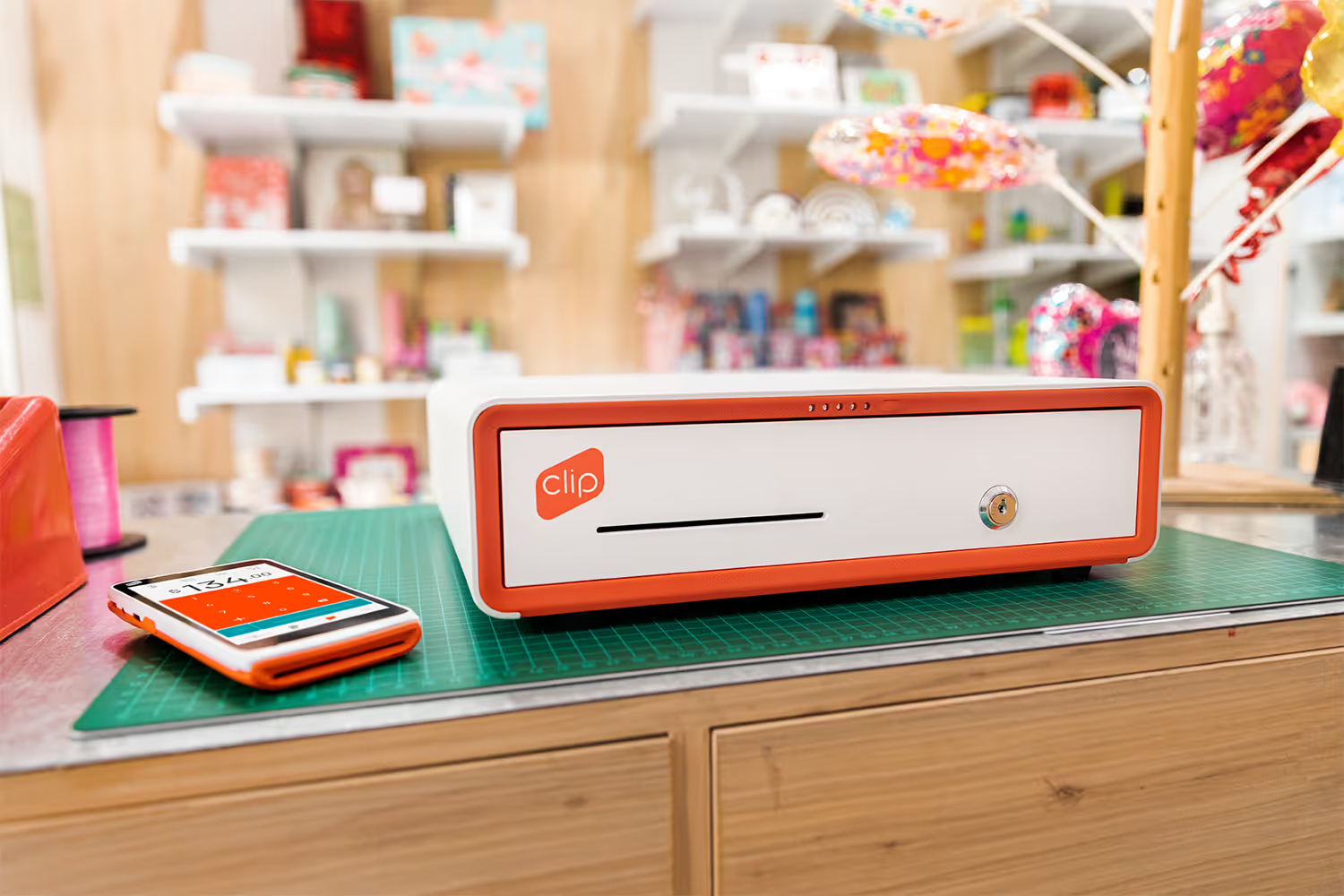.avif)
What is a POS (point of sale terminal)?
Point of sale terminal (POS) means an electronic device that processes payments with credit cards, debit cards, grocery vouchers and electronic wallets that are used in both physical businesses and in locations that are not always stationary.
It consists of software and hardware that in combination allow the processing of a transaction, so that with any plastic (credit cards, debit cards or vouchers) it is possible to make a payment no matter if they are from the same bank or are backed by different institutions.
What role does the POS play?
Its main function is to process the card payment, which happens because the Point of Sale Terminal becomes the medium between card-bank-deposit account. This way, once a customer pays with a card, the POS uses software that processes information, validates the balance and transfers it to the store account.
With technology development, any business can have a terminal, regardless of the type of products it sells, whether it offers any type of service, is a freelance or a consolidated company with several branches, it is very likely that customers will feel more comfortable paying with a card.
Businesses alone, however, cannot create a system to accept cards, as they must follow certain guidelines provided by institutions such as Visa, MasterCard or American Express and developing it would cost a fortune for them, so they need an external terminal to make it happen.
In spite of this, many businesses, either due to lack of knowledge, lack of decision or because they do not see the need, are not implementing card payment and this is taking away their profits.
What are the types of terminals?
It could be said that, due to their characteristics, there are three types of POS terminals on the market:
Traditional or bank terminals: having a software that processes the payments and a hardware that reads the card to accept the sales. This may be connected to an Ethernet cable to receive a signal from the banks or it may be wireless, being connected to your business's Wi-Fi network.
This is called banking as it is provided by the banks to any business that requests it.
Virtual: very popular in e-commerce, it is an online payment system that enables stores to accept card payments over the Internet. These systems require to be hired by the e-commerce.
Mobile: typically connects to a mobile device (cell phone or tablet) and requires mobile data or Wi-Fi to receive a signal. When you need portability in your business or need to move to different places to make your sales, you can use it as a good option.
Mobile versions have the same functionalities as a traditional terminal, however, they are not linked to a bank.
Businesses need to know the differences between a traditional terminal and a mobile one.
Differences between traditional and mobile terminals
Traditional terminals belong to a banking institution, so they are also known as bank terminals and generally charge a commission if you are paid by credit card and another one if you are paid by debit card; also, the amount of the commission changes depending on your business line.
For portable terminals, commission is fixed regardless of the type of card or line of business. This could be the main difference, although there are other distinctions, about which more details will be discussed later.
For the time being, we will mention the commissions charged by bank terminals, but in order not to go into detail, we will talk about the averages indicated by Banxico in its document "Discount rates paid by businesses for accepting card payments".
For instance, in the case of a debit card transaction, the average commission in a beauty salon is 2.87%, that is, if a transaction of $100 pesos is made, the bank keeps $2.87 pesos. The average commission for a credit card transaction in the same line of business is 3.02%, which means that if you make a transaction for $100 pesos, the amount the bank withholds as commission is $3.02 pesos.
In the case of mobile terminals in the Mexican market, they charge an average of 3.52% of each transaction plus VAT. In this case, the 16% VAT is applied to the amount obtained from the 3.52%. Let's make an example: for each transaction of $100 pesos, $3.52 pesos are withheld and $0.56 pesos for VAT. So you are deposited $95.92 pesos.
There are other amounts charged in the case of traditional or conventional terminals, while for mobile terminals, only the commission fee applies.
Payments for terminal ownership
A common charge at bank terminals are monthly fees, and these are a deterrent for small businesses, because a monthly rent can make a huge difference.
Many banks ask for a minimum monthly billing (the average is around 25 thousand pesos per month) to avoid this charge, and if you don't complete it, you will have to pay from $100 to $300 pesos as rent, depending on the institution.
Mobile terminals do not charge fees of any kind, just buy them and they are ready, because they are immediately property of the business, and only the commission will be retained, but if a business stops using them for a long period of time and uses them again, there will be no penalties or hidden charges for lack of use.
Equipment fees
There are different models of traditional terminals, the most common are the fixed one that connects to the internet via wired, the wireless one that connects via WiFi and the one with cell phone connection.
In order to have them, you will have to pay a monthly rent ranging from $100 to $300 pesos, depending on the model, which you will not be able to exempt because you are renting the device. In case you choose the model with cellular connection, you must add a monthly cost for the chip line, which also varies depending on the financial institution.
For the mobile terminals the cost varies and ranges from $299 to $749 pesos for the simplest reader, however, once you buy it, it is yours and you do not pay extra fees or rentals. Although, for the simplest model, a cell phone or tablet is needed for it to work, since the mobile device downloads the application allowing it to function properly.
Other options of mobile terminals are more expensive, but they already have an integrated device very similar to a cell phone and include the mobile line that provides internet connection and for which you do not have to pay extra. Some also include ticket printers and extra functionalities completely free of charge.
Notice the details in the small print
You should verify the scope when contracting a terminal from the bank, since many times it includes penalties for not meeting a minimum balance, and if you need another terminal then you must pay what we have already mentioned for each one of them.
No mobile terminal makes an extra charge to the commission for each transaction and you must buy each one you need.
One thing you should pay attention to is what type of cards the terminal accepts, usually American Express has a higher rate (from 4.9% to 2.9%). Something similar happens with cards from other countries, as the commission is also higher. This does not happen with portable terminals.
For you to have a clearer idea of the options available in the market, we present a comparative table of Clip devices, their main features and differences.
It will depend on the terminal you want, but here we share with you the minimum requirements. For a traditional bank terminal it is necessary, as a first step, that you have a business account with the financial institution or bank, if you do not have it, the process may take longer because you must first obtain it and then build a credit history for a minimum of three months.
- Depends on each bank, but usually the requirements are to go to the nearest branch with the following papers:
- Check account
- Proof of address
- Identification
- RFC
- Bank statements and tax returns
- Articles of Incorporation in the case of a legal entity
- No bad credit history in the credit bureau.
- Pay a membership fee ranging from $200 to $300 pesos.
With portable terminals, all you need is to buy the device, a cell phone (usually a mid-range one is enough), open your account on the terminal's website and a CLABE account where your transactions are deposited.
However, there are solutions that do not need a cell phone or tablet to connect, as they are totally autonomous, so they are more like a hybrid between a cell phone and a point of sale terminal.
How does a POS terminal work?
Typically, in the course of a transaction, a Point of Sale Terminal, regardless of whether it is traditional or mobile, performs the following for the authorization of payment:
- When the card is swiped at the POS, the information contained on the customer's card is read. This can be through the chip, magnetic stripe or contactless technology.
- The bank of the business asks whose card it is and connects with its back-up and its bank.
- The security system supporting the plastic (Visa, MasterCard, Amex, Carnet, etc.) reviews the information and approves or rejects the transaction.
- Information is sent to check if the card has funds in the customer's bank account to make a transaction. Otherwise, the transaction is declined, but if it does not, the user's bank accepts the transaction and continues.
- Visa, MasterCard or Amex approves the transaction.
- The bank of the business sends the approval to the business.
Step two is clearing, a process that usually happens at a closing period of the business, bank or institution that indicates that your day is over.
- The bank of the business sends the information to the transaction authorizing institution.
- The clearing system (MasterCard, Visa, Amex) verifies the information and approves the amounts.
- The clearing system sends sale and purchase information to the business and cardholder, respectively.
The last step is settlement, typically occurring the day after the transaction.
- The bank of the business reminds the institution about the clearing.
- The clearing institution notifies the customer's bank to settle the debt.
- The customer's bank pays the bank of the business
- Bank of the business deposits the amount to the bank account of the business.
- Records the sale and issues a receipt, which can be printed or digital.
Everything happens in a few seconds and it is possible thanks to the technologies and security protocols established by MasterCard, Visa, American Express or Carnet, as conciliating institutions.
It should be noted that in any of the options, you will not have the money immediately in your account until 24 to 48 hours after the sale. This is due to the security protocols followed by the POS and cards, mainly because you must verify that the issuer authorized the payment.
There are options, however, where the deposit of your money can happen up to 4 hours after the transaction, since the collection system is connected to your deposit account, as is the case with Cartera Clip.
When there are no problems detected, the payment will be processed to your account and on the day of the deposit, a statement will be sent to you describing each of the transactions that took place the previous day.
On the day you are deposited, you will receive a statement describing each of the transactions you had the previous day, provided by both of them.
Additional advantages of having a bank terminal
Not only does this device allow you to accept card payments, but it also offers clear benefits such as increasing the number of shoppers and your average ticket. Accepting cards doesn't limit your customers to the cash they carry in their pockets. According to a quantitative study conducted by Clip in December 2018, 9 out of 10 users increased their sales by up to 10%.
Equally important information is shown by MasterCard, which points out that businesses that offer card collection increase their average ticket by 30%.
The security of your business also improves. This is for several reasons, the first of which is that you stop using as much cash as before, although it is practically impossible to stop receiving cash, the cash flow decreases even if you continue to sell more. Additionally, your trips to the bank to make deposits will be fewer or with a smaller amount of cash, which reduces the loss in case of theft or misplacement and, lastly, reduces the risk of receiving counterfeit money.
Something that few take advantage of, but that could bring even better benefits, is that it facilitates your inventory management, since you can use point of sale systems that connect with your terminal and mark the products you are selling, know which ones you still have left and plan orders to your suppliers in advance. Some solutions already include an integrated POS system to make your job simpler.
One of the advantages is that it speeds up your sales process by not having your customers waiting for change or not having enough cash. This makes cashing up easy and simply by using the terminal you will be able to improve the way you deal with your customers.
One thing that a point of sale terminal will allow you to do is to check all your income without problems, review your account statement, have a summary of transactions at hand and above all, maintain your accounting up to date in a simpler way. This will facilitate the entire administration of your business.
When you have a point of sale terminal, you will be able to offer interest-free months so your customers can make larger purchases with deferred payments. This usually works with all cards in mobile terminals, but in the case of bank terminals, it depends on the bank's agreements with other financial institutions.
In addition, some mobile terminals offer extra products such as a digital wallet designed exclusively for the business, with unique advantages such as no commissions or the availability of money in less than 4 hours.
Also, there are some terminals that offer the option of providing telephone balance to customers with the main cell phone companies in the country. Although this is an opportunity to provide more services to your customers, of course, you should review all the available options in the market.
Credit and debit card growth in Mexico
Why is it important for a business to offer card payment? Simply because in Mexico, according to figures from the Banco de Mexico, there are more than 24.3 million credit cards and almost 127.3 million debit cards.
Then, the lack of a point of sale terminal would put you at a disadvantage compared to your competitors, given that in Mexico and around the world paying with non-cash means is a trend.
Consider this situation briefly: in 2012 there were 92.6 million debit cards, seven years later the number of active cards increased by almost 60%, i.e., by the first quarter of 2021 there are close to 153.9 million plastic cards (as per data from the Banco de Mexico).
These 153.3 million do not mean that they are the number of people with cards (the population in Mexico is 129.2 million people) but it is concentrated in 54 million Mexicans, 68% of the population aged 18 to 70 years, according to the third National Survey of Financial Inclusion (ENIF) 2018, this means that the number of sales opportunities is huge and so, your business take advantage of these small benefits.
In accordance with the ENIF, 8.3 million people have a credit card; yet, central, eastern and southern areas of the country have the lowest percentage of accounts compared to the north.
Although great efforts of inclusion are being made in these areas to level them through the promotion of digital means of payment that are safe and reliable. There is also the Mexico government Banco Bienestar plan to achieve more banking penetration for all people in the country and start using cards.
How much money do Mexicans spend with cards?
Based on Banco de México (Banxico) figures, from January to March 2021, credit and debit cards were used 923.1 million times, in which 581,193 million pesos were spent during the first three months of 2021.
Figures even go further and explain how many times debit cards were used at point of sale terminals (728.4 million times), spending 390,287 million pesos.
Each debit card transaction at a terminal averaged $535.77 pesos.
Although the credit card was used fewer times, 194.6 million times, however, spending was higher each time it was used, as on average each transaction was $980.73 pesos, meaning $190,906 million pesos spent in the first quarter of 2019 through credit cards.
Based on this data, businesses have an idea of the importance of a mobile terminal: using it, not only can they make collections, but they can also do so for higher amounts because it is not every day that a customer decides to spend more than a thousand pesos in cash.
This also explains in a clearer way the data from MasterCard and Clip, in which it points out that a business with a terminal increases its average ticket.
Knowing more about this device and considering accepting card payments, you may be considering which terminal is best for your business.

As a leading fintech company, we are frequently under the spot.
Go to Clip in the news*Spanish content only
By clicking Subscribe you're confirming that you agree with our Global Policy.


Explore our current positions. Your next job could be around the corner.
Go to careers




